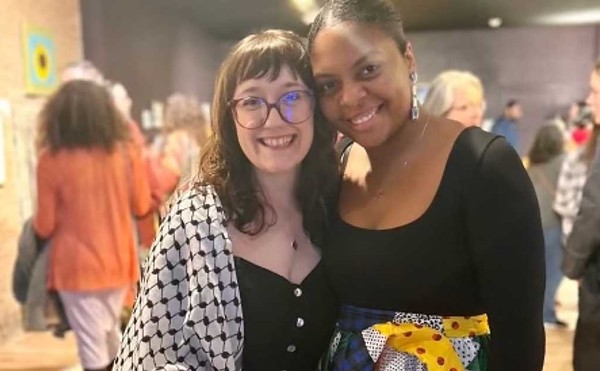For that exemplary poet of the modern metropolis Charles Baudelaire, change is bittersweet. In an 1857 ode to his beloved Paris, titled "The Swan," he writes: "the form of a city, alas/Changes more quickly than the heart of a mortal." Nostalgia, curated by former Royal Oak gallery owner Barbara Bunting, is about the beating of hearts. Bunting, who reappears on the local scene with this show after eight years as a private consultant, knows something about the bittersweet nature of change. As a young university student, she was forced to leave her native Poland in 1968 when democratic movements springing up across the Eastern bloc were suppressed. Her journey took her first to France, then to Italy, before she finally arrived in the United States. Living with regret over what's been left behind in her native land is a theme Bunting long wanted to explore in an art show.
Where the Shrinking Cities exhibit at Cranbrook Art Museum and MOCAD attempts to survey the forces driving urban change, Nostalgia registers the psychological and emotional effects of change that otherwise get lost in the glut of architectural models, redevelopment proposals, photo documentation and videos at the museums.
The old can never be left completely behind. The way things were hovers in the back of the mind, if only for measuring the new and supposedly improved. Nostalgia is a way of coming to grips with the physical, social and mental dislocation that's occurred as the pace of life has quickened with the spread of modern culture around the world. This is especially true in recent years,as globalization has unleashed a torrent of change.
Three of the artists in Nostalgia are, like Bunting herself, immigrants who came to America from Eastern Europe. The youngest artist in the show, 25-year-old Miroslav Cukovic, is also the newest arrival, coming to this country from Yugoslavia less than a decade ago. His sound installation mashes up Serbian folk music and Indian techno — itself a product of British postcolonial migration — playing over speakers set above a beanbag chair in a corner beneath a canopy of air-filled packing cushions. Waves of sound, old and new, "authentic" and hybrid, wash over the listener, giving a sense of the ebb and flow of cultures abandoned and assimilated into.
The archaic permeates the work of Lithuanian-born Renata Palubinskas. She renders neo-medieval fantasies with razor-sharp precision, conjuring up Hieronymous Bosch by way of René Magritte. Her obsession with detail is complemented by ornately carved and gilt wood frames, imported from the "old country"; these frames set off the artist's enigmatic scenes from the gallery wall and heighten their aesthetic and spiritual distance from the materialism of the industrial age. Preservation of the European craft tradition is poignantly realized in "Real Circus." Palubinskas had her father, back home in Lithuania, make a wooden figurative sculpture of a young girl in a pinafore holding a rat in her outstretched arms. He then shipped the figures to her in Detroit for painting. Their work together is an example of how craft knowledge in European folk cultures is passed down through family lineage.
Moscow-born conceptualist Irina Nahkova, who taught at Wayne State University in the mid-1990s, is an internationally known artist-nomad. Her oversized teddy bear of billowing white parachute silk takes up the front third of the gallery and mechanically inflates as viewers draw near. A symbol of Mother Russia, the bear lies face down like a praying supplicant before a wall of digital prints constructed of torn advertisements for a plethora of consumer goods. It's a wistful homage to the utopia of abundance that the Soviet system never delivered.
The tendency to dwell on things past becomes more pronounced as one matures — there's simply more past to remember. And so it is that the most compelling statements in Nostalgia are those of the group's senior members. Retired Wayne State sculpture professor Sergio De Giusti creates a new body of work that radically departs from his many public commissions commemorating the life and times of the people of Michigan, such as the labor memorial in Hart Plaza in downtown Detroit. Here he has wall-mounted bas-reliefs cast from wax originals in hydrostone, a type of plaster that, with its look and feel of bleached-white bone, evokes oblivion. Based on Gothic altarpiece forms, the work consists of empty folded shrouds and the dribbles of expended votive candles. In the show's catalog essay, poet and Metro Times art critic Glen Mannisto interprets the shrouds as "bandages concealing loss — of meaning, of faith, of memory and maybe the ability to adequately represent the inner life." Suggesting spirits departed and prayers unanswered, the shrouds symbolize regret for what sociologist Max Weber terms "the disenchantment of the world" under modernity, the mystical realm snuffed out by rationality and technology in the rush to control physical and human nature.
Another longtime Detroiter, Mel Rosas, also shows absorbing new work. Deceptively small in scale, his card-size paintings on wood are among the best work that Rosas has ever done. On the surface, the paintings appear to take their cue from cheesy, sentimental souvenir photos of Latin America. They're actually sophisticated, imaginative constructions. Dense layers of built-up pigment, at times to the point of sculpted relief, invest each scene with a material particularity that runs counter to the slick banality of manufactured tourist commodities and what another sociologist, George Ritzer, calls the "globalization of nothing." Signs with ambiguous meanings, figures and objects in unclear contexts, and paint-handling that alternately reinforces and subverts illusion make these images more than mere representations; they're open to a variety of interpretations as aesthetic objects in and of themselves.
Bunting hopes to follow Nostalgia with other projects in the coming months. It would be great to have her voice back in the cultural conversation, and that's hope for the future, not nostalgia in the least.
Nostalgia runs until March 31, at Neal Davis Gallery, 413 W. Fourth St., Royal Oak; 248-298-0326. The show is accompanied by a catalog featuring an essay by Glen Mannisto. A gallery talk is 7 p.m. Thursday, March 22.
Vince Carducci writes about art and culture for Metro Times. Send comments to [email protected]





